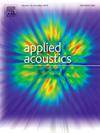Research on pipeline flange leakage detection method based on random forest and Pearson correlation coefficient
IF 3.4
2区 物理与天体物理
Q1 ACOUSTICS
引用次数: 0
Abstract
Pipeline flange leakage is influenced by multiple factors, including discharge area, temperature, pressure, flow velocity, and installation position. Conventional leakage prediction models suffer from computational inefficiency and reduced generalizability due to high-dimensional feature spaces and redundant parameters. To overcome these limitations, this study introduces an interpretable hybrid framework integrating Random Forest (RF)-driven feature selection with Pearson correlation analysis for high-precision leakage diagnostics. Vibration signals were systematically acquired from paired upper and lower flanges at leakage-critical regions, followed by extraction of multicomponent features including total vibration energy, spectral kurtosis, centroid frequency, Shannon entropy, and bidirectional cross-correlation metrics. Through rigorous RF-based recursive feature elimination, four dominant sensitivity indicators were identified: inter-flange cross-correlation (CC), upper-flange centroid frequency (CF), total vibration energy (TVE) of both flanges, and downstream entropy (DE). Subsequent Pearson correlation mapping revealed minimal collinearity (|r| < 0.4) between CC, CF, and lower-flange TVE, establishing these orthogonal features as prediction model inputs. A Multilayer Perceptron (MLP) network is trained to establish the leakage prediction model. Experimental results demonstrate high accuracy of the proposed method, achieving a mean squared error (MSE) of approximately 6.8 and a coefficient of determination (R2) of 0.97. The feature dimensionality reduction not only improves prediction accuracy but also reduces iteration cycles.
基于随机森林和Pearson相关系数的管道法兰泄漏检测方法研究
管道法兰泄漏受多种因素影响,包括排放面积、温度、压力、流速、安装位置等。传统的泄漏预测模型由于高维特征空间和冗余参数,存在计算效率低、泛化能力低的问题。为了克服这些限制,本研究引入了一个可解释的混合框架,将随机森林(RF)驱动的特征选择与Pearson相关分析相结合,用于高精度泄漏诊断。系统地获取了临界泄漏区域上下法兰的振动信号,然后提取了包括总振动能量、谱峰度、质心频率、香农熵和双向互相关指标在内的多分量特征。通过严格的基于rf的递归特征消去,确定了4个优势敏感性指标:法兰间互相关(CC)、法兰上质心频率(CF)、两法兰总振动能量(TVE)和下游熵(DE)。随后的Pearson相关映射显示最小共线性(|r| <;0.4) CC、CF和下法兰TVE之间的关系,建立这些正交特征作为预测模型输入。通过训练多层感知器(MLP)网络建立泄漏预测模型。实验结果表明,该方法具有较高的精度,均方误差(MSE)约为6.8,决定系数(R2)为0.97。特征降维不仅提高了预测精度,而且减少了迭代周期。
本文章由计算机程序翻译,如有差异,请以英文原文为准。
求助全文
约1分钟内获得全文
求助全文
来源期刊

Applied Acoustics
物理-声学
CiteScore
7.40
自引率
11.80%
发文量
618
审稿时长
7.5 months
期刊介绍:
Since its launch in 1968, Applied Acoustics has been publishing high quality research papers providing state-of-the-art coverage of research findings for engineers and scientists involved in applications of acoustics in the widest sense.
Applied Acoustics looks not only at recent developments in the understanding of acoustics but also at ways of exploiting that understanding. The Journal aims to encourage the exchange of practical experience through publication and in so doing creates a fund of technological information that can be used for solving related problems. The presentation of information in graphical or tabular form is especially encouraged. If a report of a mathematical development is a necessary part of a paper it is important to ensure that it is there only as an integral part of a practical solution to a problem and is supported by data. Applied Acoustics encourages the exchange of practical experience in the following ways: • Complete Papers • Short Technical Notes • Review Articles; and thereby provides a wealth of technological information that can be used to solve related problems.
Manuscripts that address all fields of applications of acoustics ranging from medicine and NDT to the environment and buildings are welcome.
 求助内容:
求助内容: 应助结果提醒方式:
应助结果提醒方式:


